Related Research Articles
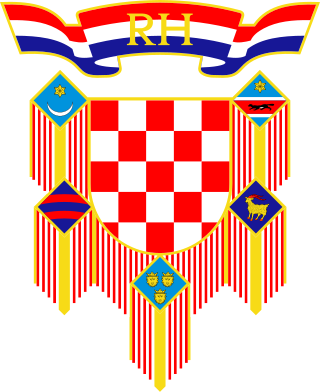
The president of Croatia, officially the president of the Republic of Croatia, is the head of state, commander-in-chief of the military and chief representative of the Republic of Croatia both within the country and abroad. The president is the holder of the highest office in Croatia. However, the president is not the head of the executive branch as Croatia has a parliamentary system in which the holder of the post of prime minister is the most powerful person within the country's constitutional framework and everyday politics.
The Government of Croatia, formally the Government of the Republic of Croatia, commonly abbreviated to Croatian Government, is the main executive branch of government in Croatia. It is led by the president of the Government, informally abbreviated to premier or prime minister. The prime minister is nominated by the president of the Republic from among those candidates who enjoy majority support in the Croatian Parliament; the candidate is then chosen by the Parliament. There are 20 other government members, serving as deputy prime ministers, government ministers or both; they are chosen by the prime minister and confirmed by the Parliament (Sabor). The Government of the Republic of Croatia exercises its executive powers in conformity with the Croatian Constitution and legislation enacted by the Croatian Parliament. The current government is led by Prime Minister Andrej Plenković.
Unique Master Citizen Number is an identification number that was assigned to every citizen of former Yugoslav republics of the SFR Yugoslavia. It continues to be used in almost all of the countries that were created after the dissolution of Yugoslavia – Bosnia and Herzegovina, Montenegro, North Macedonia, Serbia and Slovenia use it in its original form, while Croatia has switched to a new identification number called the Personal Identification Number.

The Adriatic Highway is a road that stretches along the eastern coast of the Adriatic Sea and is part of the European route E65. The road passes through Croatia, with smaller stretches through Bosnia and Herzegovina and Montenegro and ends at the Montenegro-Albania border. It is an undivided two-lane road for almost its entire length, with the exception of a short stretch through Zadar and a 24 kilometres (15 mi) dual-carriageway section from Plano (Trogir) to the southeast suburbs of Split. It was planned in the 1930s and built in the 50s and 60s. The dual carriageway is planned to be extended further southeast to Omiš. Completion of the Adriatic Ionian motorway is proposed in order to replace Adriatic Highway as a high-performance road transport route along the Adriatic coast.

Municipalities in Croatia are the second-lowest administrative unit of government in the country, and along with cities and towns they form the second level of administrative subdisivion, after counties. Each municipality consists of one or more settlements (naselja), which are the third-level spatial units of Croatia.

The Croatian identity card is an identity document issued in Croatia. Any Croatian citizen who is resident in Croatia can obtain an ID card and it is compulsory for all citizens over the age of 18. This document is issued by the police on behalf of the Ministry of the Interior.

D41 is a state road in the central Croatia connecting Križevci to Koprivnica and Gola border crossing to Hungary. The road is 57.9 km (36.0 mi) long.
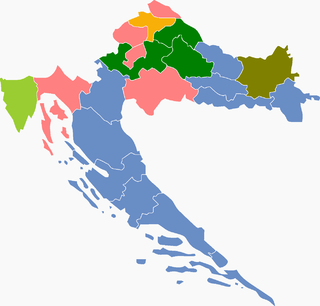
Local elections were held in Croatia on 17 May 2009, with the second round held on 31 May where necessary.

The Security and Intelligence Agency is the Croatian security and intelligence service founded in 2006 upon the passing of the Security and Intelligence System of the Republic of Croatia Act and by combining the former Counterintelligence Agency (POA), and the Intelligence Agency (OA) which both ceased to operate.

D23 state road, connects cities and towns of Duga Resa, Josipdol and Senj, to the state road network of Croatia, and most notably to A1 motorway in Žuta Lokva interchange, as well as two major state roads - D3 and D8, located at the northern terminus and the southern terminus of the road respectively. The road is 103.9 km (64.6 mi) long. The route comprises a significant number of urban intersections, in segments of the road running through Duga Resa and Senj.
The ministry of Maritime Affairs, Transport and Infrastructure of the Republic of Croatia is a ministry in the Government of Croatia.

D504 is a state road in Lika region of Croatia connecting the D1 state road to Ličko Petrovo Selo border crossing to Bihać, Bosnia and Herzegovina via the D217 state road. The road is 9.9 km (6.2 mi) long.
The Register of Protected Natural Values of the Republic of Croatia has been created according to the Nature Protection Act in 2005. The register is being administered by the Administration for Nature Protection within the Croatian Ministry of Culture. The register serves as a reference database and unique official data source about protected areas in Croatia. The data in this register is public with the exception of special cases of confidentiality regarding the position of certain protected natural goods. The Nature Protection Act stipulates nine categories of protected areas.
The national symbols of Croatia are insignia, icons, or cultural expressions that are emblematic, representative, or otherwise characteristic of the Republic of Croatia, Croatian people, or the Croatian culture. They are being implemented within the country and abroad as a form of representation for the nation's statehood or its unique cultural aspects.
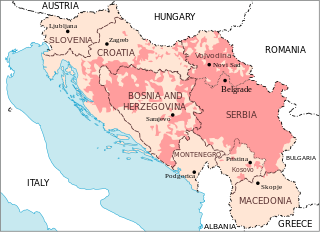
From August 1990 to November 1991, during the breakup of Yugoslavia, several Serb Autonomous Regions, or Districts were proclaimed in the Yugoslav republics of SR Croatia and SR Bosnia and Herzegovina in light of the possible secession of the republics from the Socialist Federal Republic of Yugoslavia. These were autonomous Serb-inhabited entities that subsequently united in their respective republic to form the Republic of Serbian Krajina in Croatia and the Republika Srpska in Bosnia and Herzegovina.
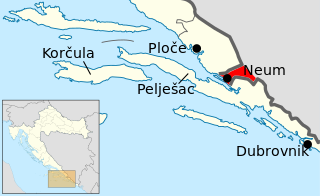
The Neum Agreement is an unimplemented treaty between Croatia and Bosnia and Herzegovina granting free passage of Croatian transit traffic between parts of the territory of Dubrovnik-Neretva County. So from the area around the city of Dubrovnik to the rest of the county, thus forming a pene-exclave within the Dubrovnik-Neretva County at the municipality of Neum.
The law of Croatia is part of the legal system of Croatia. It belongs to the civil law legal system. It is grounded on the principles laid out in the Constitution of Croatia and safeguarded by the Constitutional Court of the Republic of Croatia.

Law on Use of Languages and Scripts of National Minorities is law which defines use of minority languages in Croatia. Additionally Croatian Constitutional law on national minorities rights and The Law on Education in language and script of national minorities explicitly define rights on usage of minority languages in Croatia.
The Government of Croatia and the Holy See have signed four bilateral agreements and a protocol. Although the agreements proved controversial owing to great one-time and continuous financial and other burdens the agreements put on the Croatian state, no government of Croatia ever attempted to amend them. From the perspective of international law, these agreements may be seen as unjust to Croatia because of putting obligations chiefly on the Croatian state, but not on the Holy See.
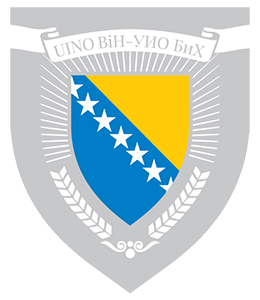
The Indirect Taxation Authority of Bosnia and Herzegovina is the national revenue service responsible for the application and implementation of legal regulations related to indirect taxation in Bosnia and Herzegovina.
References
- 1 2 "Izvješće o radu Carinske uprava za 2022. godinu" (PDF). carina.gov.hr. Retrieved 23 February 2024.
- ↑ "Plan prijedloga za razdoblje 2023. - 2025" (PDF). carina.gov.hr. Retrieved 23 February 2024.
- ↑ "Područni carinski uredi". carina.gov.hr. Retrieved 23 February 2024.
- ↑ Tuđman, Franjo (8 October 1991). "UKAZ o proglašenju Carinskog zakona". Narodne Novine. 53. Retrieved 23 February 2024.
- ↑ Grgurica, Nenad (June 2015). "Uspostava cjelovitosti carinskog sustava tijekom Domovinskog rata". Carinski Vijesnik. 11: 7–8.
- ↑ "Resolution 743". nscr.com. Retrieved 23 February 2024.
- ↑ "Resolution 769". unscr.com. Retrieved 23 February 2024.
- ↑ Međimorec, Miroslav (1 March 2003). "Politički i diplomatski napori RH i MZ da se postigne mirna reintegracija okupiranih područja i puni suverenitet na cjelokupnom državnom prostoru". National Security and the Future (in Croatian). 4 (1–4): 34. ISSN 1332-4454 . Retrieved 23 February 2024.
- ↑ Markotić, Gordan (April 1995). "Sankcije Ujedinjenih naroda protiv tzv. SRJ i provedbeni propisi Republike Hrvatske". Carinski Vijesnik. 7: 13.
- ↑ "Resolution 820". unscr.com. Retrieved 23 February 2024.
- ↑ "Carinska ispostava u Kninu". Vijesnik. 25 September 1995.
- ↑ Bošnjak, I. (4 December 1996). "Prijelazna carina započela rad". No. 40. Glas Slavonije.
- ↑ Knezić, Josip (June 1997). "Hrvatski stijeg na granici sa SRJ". Carinski Vijesnik. 7: 3–4.
- ↑ "Uredba za provedbu carinskog zakona". Narodne Novine. 53. 25 September 2003.
- ↑ "Uredba (EU) br. 952/2013 Europskog parlamenta i Vijeća od 9. listopada 2013. o Carinskom zakoniku Unije". Službeni list Europske unije. 269 (1). 10 October 2013. Retrieved 24 February 2024.
- ↑ "Areas of EU action - European Commission". commission.europa.eu. Retrieved 24 February 2024.
- ↑ "Zakon o carinskoj službi". Narodne Novine. 83. 15 July 2009. Retrieved 24 February 2024.